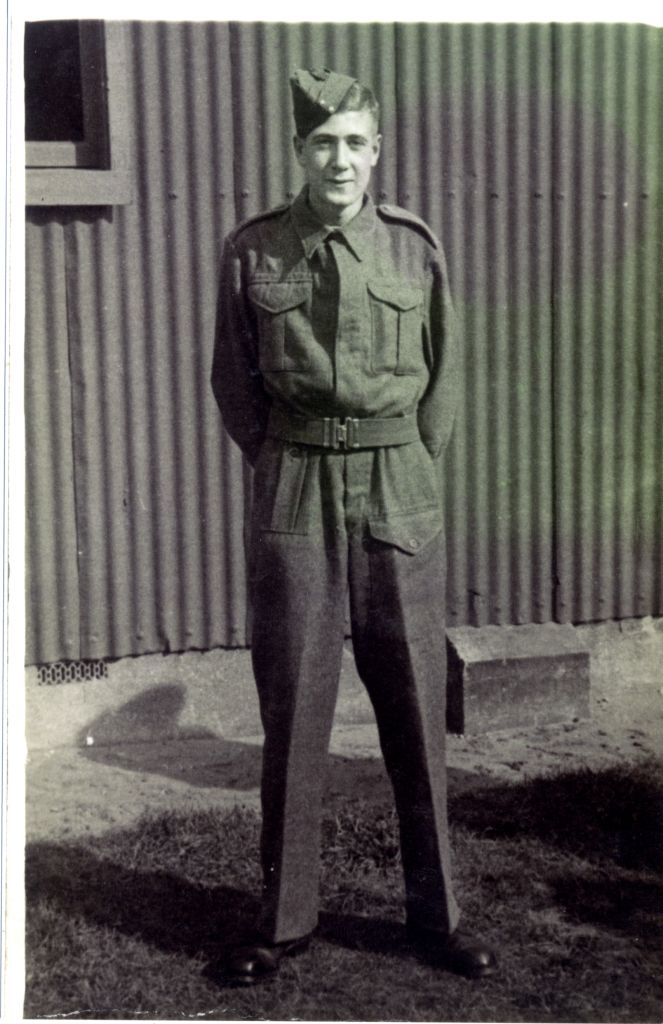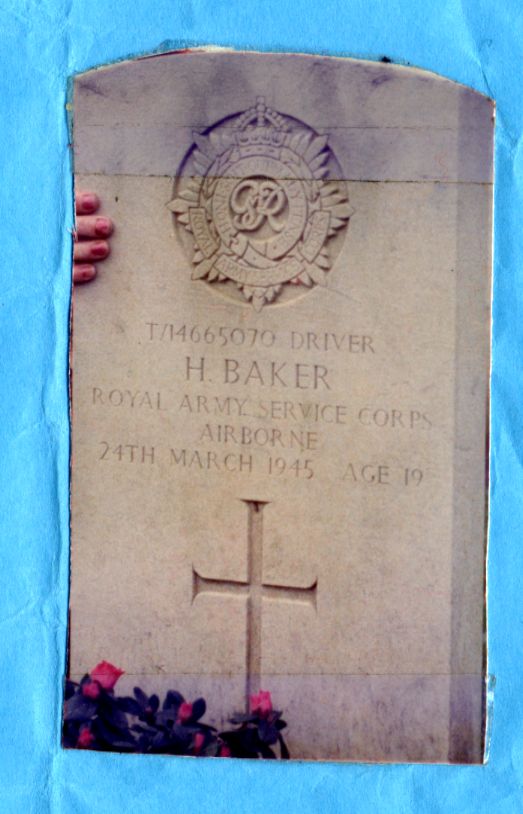Harry Baker
Date of birth: 15.8.1925
Date of death: 24.3.1945
Area: Pontefract
Regiment: Royal Army Service Corps
Family information: Son of Louis and Hilda Baker
Rank: Driver
Service number: T/14665070
War Service
Harry Baker was a cobbler at Pontefract barracks before the war, so he had no need to join up. However, he decided to enlist into the General Service Corps at Ladylare Recruitment Centre in Leeds.
On 14th September 1943 he started his basic training in Ireland. After which he was transferred to Royal Army Service Corps and was later posted to 716 Airborne LT Company R.A.S.C. Harry, being a tall lad of 6ft 2, was soon nicknamed ‘Lofty’ by his fellow trainees. A fellow soldier said that Harry should have been a guardsman not a Para-he was too smart!
Whilst training for the D Day landings in Normandy, Harry hurt his foot during a practice jump over the Thames. He was in hospital in Salisbury and later returned home for a short leave to recoup from his injuries; therefore he did not go to Normandy with the rest of his unit. It was at this time the 716 Coy home details had moved from Figsbury to a little village called Minstead in the New Forest.
By Christmas 1944 they had settled into their new home and had repaired the gaps in the unit’s equipment and had made friends with the villagers. The Christmas dance, church service and children’s party were all organised but they were not to be enjoyed by the lads.
Christmas Day 1944 they were at Tilbury Docks awaiting transportation to the Ardennes in Belgium. During his time in the Ardennes he tried to get a German helmet for his Dad and nearly got killed in the process.
They were to join up with the division (6th Airborne) to stem the breakthrough lines with the U.S. in the Battle of the Bulge. It was a bitterly cold winter with six feet of snow in some places. It was known as the ‘White Hell’ because it was so cold.
At the end of February, Storky Crane (Major C.P.R. Crane O.C.) gathered his officers and told them of a new operation. They had a speedy return home via Ghent Ostend back to Minstead. This new operation was to be the Rhine Crossing, which it was hoped would complete the collapse of Hitler’s Reich. This time they had a new mode of transport. 716 Coy, part of 6th Airbourne Division No.3 parachute platoon (C troop) were to be flown in Hamilcar Gliders, which were equipped with Bren carriers and trailers to act as pathfinders (as well as being a commando unit). Approximately 80 troops drawn from all ranks and platoons were transported in 12 Hamilcars with 12 carriers.
Early on the 24th March 1945 the Gliders set off from Brize Norton in Oxfordshire. The landings were very widespread and hazardous due to poor visibility because of dust from the barrage that was waiting for them. For many days barely 50 percent of the airborne party could be mustered.
The Glider 273 was one of those that overshot the landing zone and they landed in an American sector.
Harry was shot in the head shortly after landing. He was given morphine by L/C Jock Fozzard and was carried on a stretcher along with another injured man to a nearby deserted farmhouse. The rest of the troops from his Glider were captured by the Germans soon after. The war diary stated that ‘Glider 273 was located with the Glider pilots dead beside it.’ Over the years I have been in touch with many of the men who were in Glider 273, they were taken prisoner and transported by train to Stalag 11 in Germany.
What happened to Harry after he was left is not known. Even by the rest of 716.
He was buried in Margraten Cemetery, which is thought to have been a temporary burial ground.
He was transferred to Venray War Cemetery in April 1947 as Margraten was designated to be an American Cemetery.
Mr. John Medlam, who was a very good friend of Harry’s during their days at Minstead did not even know that Harry had died on the Rhine Crossing until 1986 when he was reading an old Pegasus magazine which gave details of the transfer from Margraten to Venray.
Family Life
Harry Baker was born 15th August 1925 at Park Dale, Airedale, Ferry Fryston. His parents were Louis and Hilda Baker of Willow Park, Pontefract. Louis worked at Bagleys at Knottingley making aeroplane glass and his mother was an auxiliary nurse.
Harry’s first school was Willow Park, Pontefract and then he moved up to Northgate Senior Boys, Pontefract, which was where Morrison’s is now. Harry was a keen cyclist and like his Dad was in the St. John’s Ambulance Brigade in Pontefract.
I was 11 years old at the time of my brother being killed. I remember the post boy bringing the first telegram saying that Harry was ‘missing’…
The next one said, ‘Missing presumed dead.’
The final one said that Harry was dead.
I’ve never seen anyone age as quickly as my Mum. She sat in the rocking chair for almost a week.
There are lots of things that I can remember…a letter arriving from Sergeant Jack Fozzard trying to explain to my mum what had happened. Harry was found by American Airbourne and was buried in an American War Cemetery for two years. Hence, it took nearly one year before we knew where he was buried. Then in 1947 his remains were moved to the Venray War Cemetery, Holland where he lies today.
Years after we learned that mum had to pay for a blanket to move his remains from Margraten because it was classed that Harry had lost his issue blanket.
My Mum would not move from Pontefract to Wakefield where Dad wanted to move for a fresh start and to get mum back to her normal self. The reason she wouldn’t move was that Harry had been shot in the head and would probably be blind and would not know where to go when he returned to England. She couldn’t accept that he was dead. She never could understand why he had enlisted.
My 2nd brother Louis joined the guards the year after Harry’s death.
Sadly, my Mum died in 1970. They had at last moved to Wakefield but she was never again the Mum we knew as kids. The last touch was Dad placing Harry’s medals in Mum’s coffin, her last touch with her first-born.
In 1986 my 2nd brother and I were given an opportunity to go on pilgrimage to Venray as guests of the Dutch Legion. It was a most moving experience to see the resting place of our dear brother, killed age 19 years old, serving his country. “God bless.”
To this day I will never forget my brother who was so proud of his red beret and para wings.
 Harry Baker in his army uniform
Harry Baker in his army uniform
 Harry Baker's gravestone
Harry Baker's gravestone

